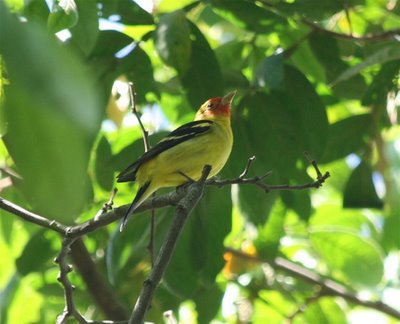
Los Tarrales has some special birds, endemics that are found only in a limited area. The blue-tailed hummingbird is one. This is a lousy picture, but you can tell what it is, and get a hint of its beauty in better light.
 One of my favorite shots from Los Tarrales is this pair of male rose-breasted grosbeaks in a flowering tree. It's hard to find them, but they look so fine in that setting! (You have to know how frustrating it is for a Science Chimp to have to describe any plant as "a flowering tree.") Agghhh. Eee. Eee.
One of my favorite shots from Los Tarrales is this pair of male rose-breasted grosbeaks in a flowering tree. It's hard to find them, but they look so fine in that setting! (You have to know how frustrating it is for a Science Chimp to have to describe any plant as "a flowering tree.") Agghhh. Eee. Eee.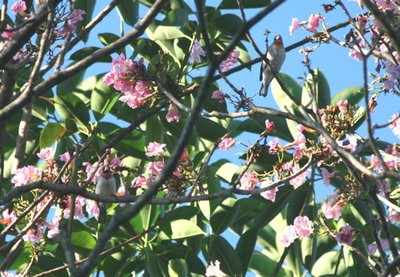 They'll be at our feeders before you know it. I noticed that most of the male rose-breasts in Guatemala had very pale pink cravats. Perhaps some white feather edges have to wear off before they will be in full spring finery.
They'll be at our feeders before you know it. I noticed that most of the male rose-breasts in Guatemala had very pale pink cravats. Perhaps some white feather edges have to wear off before they will be in full spring finery.Woodcreepers are part of a large Neotropical family called the Dendrocolaptidae. Most are variations on a theme of burnt sienna. Many have spine-tipped tails, like woodpeckers, but they're not generally as robustly built as woodpeckers, since they tend to probe and glean rather than hammer for their food. They're tame and easy to spot as they work the bark, mosses and epiphytes on forest tree trunks. One of the commonest is the ivory-billed woodcreeper, a nice hearty bird with a spine-tingling name.
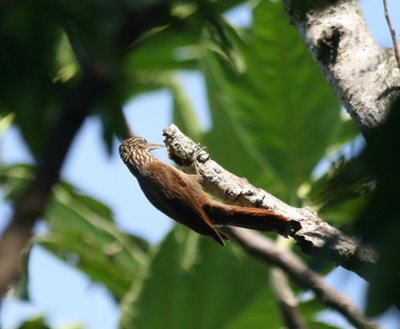 Long, flexible necks and a slightly decurved bill allow this IBWC to probe into forgotten crevices, looking for insect and invertebrate prey.
Long, flexible necks and a slightly decurved bill allow this IBWC to probe into forgotten crevices, looking for insect and invertebrate prey. 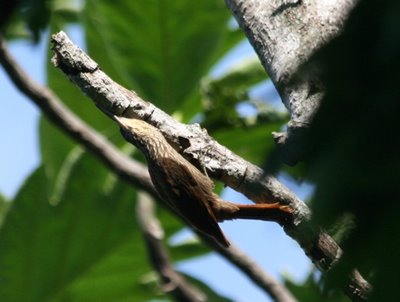 It's always surprising to see the positions a bird can get into when it's foraging. If you're used to our robust woodpeckers, woodcreepers look kind of willowy and gracile in comparison, with fine legs, toes and bills, and soft fluffy plumage.
It's always surprising to see the positions a bird can get into when it's foraging. If you're used to our robust woodpeckers, woodcreepers look kind of willowy and gracile in comparison, with fine legs, toes and bills, and soft fluffy plumage.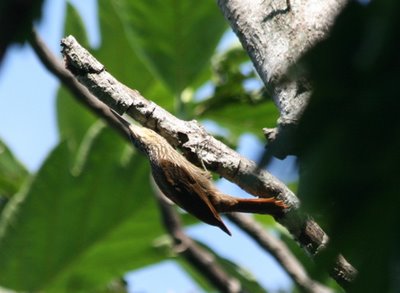
And speaking of ivory-bills, here is the tropical Campephilus that always raises the hair on the back of my neck with its double-raps and yapping calls--the pale-billed woodpecker. Ba-DOCK! Yip yip yip yip! I guess "Ivory-billed woodpecker" was already taken.
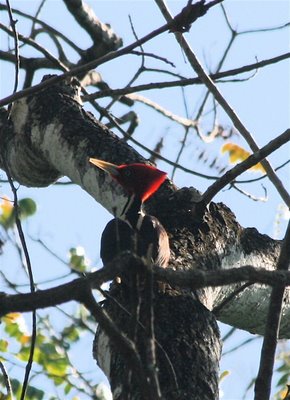 I shot photo after photo as it hitched up the tree, its massive bill and flaming crest backlit by morning sun. Would that our Campephilus were so cooperative, but who can blame it for shunning the company of man?
I shot photo after photo as it hitched up the tree, its massive bill and flaming crest backlit by morning sun. Would that our Campephilus were so cooperative, but who can blame it for shunning the company of man?I got an e-mailed response from Dr. Stephanie Doucet, Asst. Professor of Biology at the University of Windsor, Ontario, who answered from her field station in Costa Rica. I asked her about tail molt in long-tailed manakins. I was kind of embarrassed to have to ask her, because the manakin painting I showed you was on the cover of the issue of The Auk (the journal of the American Ornithologists' Union) that featured her awesome article about...molt in long-tailed manakins. As the cover artist, I was provided a copy, and I can't find it; it's probably swallowed in the bowels of my big wooden flatfile. Duh. She sent me a copy of her article, which is absolutely fascinating; she mist-netted and color-banded 1,315 long-tailed manakins to figure out what was going on with their plumage development. It takes young males FIVE YEARS to come into definitive adult plumage! And she figured out how to tell exactly how old a manakin was, up to age five, by its plumage. Obviously, manakins can tell, too, and the social implications of wearing your age like a badge are multitude. It all plays into that odd lek-based mating system, where social rank and age determine whether a bird can pass on its genes. Anyway, Stephanie was kind enough to write to say:
In answer to your question, they re-grow their central rectrices (tail feathers) each year,
and as they go from juvenal plumage to definitive adult plumage, their tails get longer every year.
So Katdoc, you were right--the older males just shed their feathers, then grow a new longer tail every year, like an older buck growing a new set of big antlers each summer. Think about that--I'm thrilled to see five or six manakins, and Dr. Doucet has banded over a thousand of them, keeping records on each one. There's interesting, and then there's amazing.
Hope you had a wonderful Easter. We did. Church, communion for 400? zzzzzz, two egg hunts, lamb gravy.
Liam: I LOVE that lamb gravy! Can I put it on my asparagus?
Me: Sure. Knock yourself out.
Liam: Suddenly, it doesn't look so appetizing.
Last night he said his bed didn't look so sleepitizing to him. That's my boy.






9 comments:
What do I say? I learned so much here tonight I'm tongue-tied. Awesome birds in Los Tarrales, Julie. woodcreepers are beautiful. Silly me served oranges for Baltimore Orioles last year. It would be a fluke for them to stop by! But, I hope to see the Grosbeaks again.
Lamb gravy on asparagas? Hey, at least Liam's willing to broaden his horizons :o)
Two eggs hunts...with coats, hats, and gloves? Please say NO.
Happy Easter.
Fascinating... and spine-tingling, all in one post... plus, next game of Scrabble I'm employing the word "sleepitizing".
What magnificent birds! I love living vicariously through you Julie. Your readers know more about those birds of Guate without ever having left the country. I am hoping for an Oriole someday.
Glad you all had a wonderful Easter day, lamb gravy and all!
I finally see an Ivory Billed Woodpecker...Campephilus at last!
Thank you, thank you!!!!
Communion for four hundred? Good Heavens! Did you actual stay for all those souls to receive the Body or did you split before the closing hymn? YIKES!
Lamb gravy? Eek.
Now I know to serve something besides oranges for my Orioles. Thanks, Sci Chimp!
"Now I know to serve something besides oranges for my Orioles."
In my area several folks have good luck attracting Orioles with plain old grape jelly, as well.
All those birds are gorgeous, but
I sat up straight when I got to the words, "commonest . . Ivory-billed wood . . " Yep. Those are attention-grabbers.
That tropical Campephilus. Handsome. Seems like with a little imagination they might have come up with something a little more worthy of his magnificence than - pale-billed.
Those Manakins and their tails - I love the analogy with deer antlers.
BTW. You get mother-of-the-year award for raising children who tolerate the presence of asparagus alongside the mash potatoes.
Oh, yeah. Definitely Mother-of-the-Year ;o) I don't know of many kids who would touch asparagus. I didn't eat it and like it until I was 25.
Post a Comment